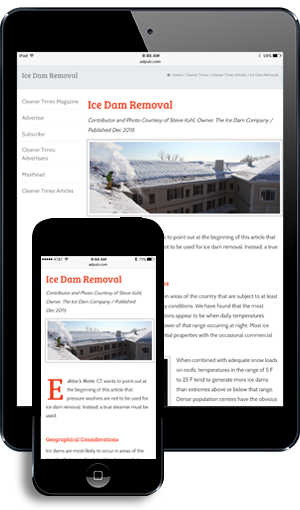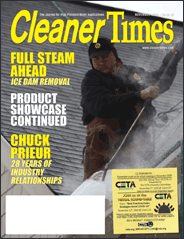
Minimizing Losses, All Losses
by Mark E. Battersby | Published November 2025

No one plans for a loss. Many smart pressure cleaning contractors and business owners do, however, plan to minimize the effect of losses, reverse them more quickly and, in some cases, reap the benefits of increased cash flow and lower tax bills today and in the future.
Whether the result of the economy, competition, or events outside the control of the pressure washing operation’s owner or manager, losses are almost inevitable. Thanks to our tax laws, however, anticipating losses–whether past, current, or future–can help every pressure cleaning business and its owner ease the bite of those losses, recover faster, and in many cases, reap a number of tax breaks.
Ensuring preferential tax treatment—and a lower tax bill—for losses should begin now, well before any loss occurs. Consider, for example, the routine losses every business may encounter.
LOSSES AND MORE LOSSES
While lost profit is not actually a loss, an unpaid invoice might be. In fact, it may be possible to write unpaid invoices off on the annual tax return. Unfortunately, these losses are available only to those pressure-washing businesses using the accrual method of accounting. This means that the total for those invoices was already included in the operation’s gross income reported to the IRS.
Business bad debts, on the other hand, are often labeled as losses. Regardless of whether the business bad debt arose from an owner’s loans to his or her business or from loans to others, so long as they are business-related, they can be deducted to the extent of their worthlessness.
Unfortunately, business bad debt deductions are not available to shareholders who have advanced money as a contribution to an incorporated business’s capital, or to creditors who hold a debt that is confirmed by a bond, note, or other evidence of indebtedness.
There are also those losses that can be controlled. Quite simply, a loss is allowed for the abandonment of an asset. If a depreciable business asset or an income-producing asset loses its usefulness and is subsequently abandoned, the loss is equal to its adjusted basis. Obviously, an abandonment loss must be distinguished from anticipated obsolescence.
And, whether a good or a bad thing, this type of loss applies to the abandonment of a business, as well as abandonment of intangible assets, such as contracts.
Inventory losses, casualty and theft losses (to the extent not covered by insurance), and losses on the sale of business assets may also be deductible. Losses from fire, storm, shipwreck, or other catastrophic events are clearly tax deductible. Of course, casualty losses must be due to a sudden unexpected or unusual event in order to qualify as tax deductions.
Casualty losses, at least if they are the result of a legitimately declared “disaster,” can be utilized to recoup taxes paid in the previous tax year. In essence, a casualty loss resulting from a declared disaster may be claimed as a tax deduction in the year preceding the year in which the disaster actually occurred. This allows the pressure washing operation to amend its prior year tax returns and receive an immediate refund as a measure of relief.
The owners and operators of many troubled pressure cleaning businesses have discovered the advantages–yes, advantages–of big-time losses.
NET OPERATING LOSSES
A net operating loss (NOL) is the total excess of allowable deductions over gross income with required adjustments. In other words, if all of the pressure washing operation’s expense deductions exceed income shown on the tax return—or the owner’s return—there may be an NOL.
Depending on how much of a loss it sustains, the business can benefit from the negative income for a prolonged period of time until it becomes profitable again. Owners of an unincorporated business—a sole proprietorship, partnership, or limited liability company—can claim their business operating losses on their annual personal tax returns.
Currently, NOLs can no longer be carried back to offset the taxable profits in earlier years. They can, however, facilitate future tax relief. NOLs can now be carried forward indefinitely although they are limited to a maximum of 80 percent of the upcoming year’s income. A 20-year limit applies for losses that occurred prior to 2018.
TOO MUCH LOSS
The One Big Beautiful Bill (OBBB) impacted the tax treatment of business losses, particularly the limited deduction for so-called “excess business losses” (EBLs). This impacts the amount of losses that a sole proprietor, partner, S corporation shareholder, or limited liability member can currently deduct.
An EBL is the excess of the pressure washing operation’s total income or gain attributable to the taxpayer’s business plus a threshold amount. The threshold amount is indexed for inflation and is $313,000 for 2025.
The OBBB also changed how total (or aggregate) business deductions are calculated by including any “specified loss”—that is, any excess business loss that was disallowed for tax years beginning after December 31, 2024—in the total amount.
LOSSES FROM PASSIVE ACTIVITIES
The tax rules are pretty clear: ordinary losses can only be deducted against ordinary gains, and capital losses can only be deducted against capital gains. Since most people usually have much more ordinary income than capital gains, ordinary losses are usually more useful than capital losses in reducing taxable income.
Passive activities are those in which the owner or shareholder doesn’t materially participate. Material participation is generally defined as being involved in an activity on a regular, continous, and substantial basis. Under these rules passive activity losses that exceed income from pssive activities are disallowed for the tax year although they can be carried forward to he next tax year where they face the same passive loss rules.
A LOSS BY ANY OTHER NAME
While not as common as it was several years ago, insolvent banks and other financial institutions can cause their customers—both individuals and businesses—to lose substantial amounts of money.
Should a bank or financial institution become insolvent, customers can deduct any non-insured losses as either casualty losses or non-business bad debts. If none of the losses were insured, an investment loss might be claimed instead.
Unlike the standard deposit insurance amount, which is $250,000 per depositor (per FDIC-insured bank, per ownership category), capital losses are limited to $3,000 ( $3,000 loss limit is the amount that can be offset against ordinary income).
When it comes to theft losses, they are tax deductible. Of course, the pressure cleaning operation must prove that the loss was due to theft—suspicion alone is not enough. What’s more, if property is simply missing, a theft loss can’t be claimed.
Increasingly the IRS is assuming two or more years of losses is enough to label an operation as a “hobby.” Quite simply, as a hobby the operation’s expenses can be deducted but only up to the amount of its income. In other words, hobbies don’t have losses that can offset income from other sources, only businesses do.
ESSENTIAL PLANNING ESSENTIALS
Planning for losses begins with the key types of losses recognized by the IRS. The tax rules allow deductions for ordinary losses from ordinary income. This reduces the amount of taxable income, and reduces the income tax bill.
Owners of unincorporated businesses who sell or liquidate their businesses at a loss are allowed to deduct those losses against their ordinary income. Owners who sell or liquidate their corporations at a loss are required to deduct those losses against their capital gains.
If their capital losses exceed their capital gains, they are allowed to deduct the loss in increments of up to $3,000 per year to offset their ordinary income. Depending on the amount of the capital loss, it may be many years before the entire loss is deducted.
PLANNING WITH SPECIAL STOCK
To give the owners of small incorporated businesses the same deduction advantages as the owners of unincorporated businesses, Congress created Section 1244 stock with a unique tax treatment for its qualified restricted shares. Section 1244 stock allows a business to report certain capital losses as ordinary losses for tax purposes. This lets new or smaller businesses take advantage of lower effective tax rates and increased deductions.
Specifically, Section 1244 stock allows shareholders of an eligible small business corporation to treat up to $50,000 of losses (or, in the case of a husband and wife filing a joint return, $100,000) from the sale of stock as ordinary losses instead of capital losses.
BOTTOM LINE
Would a refund of taxes paid by the formerly profitable pressure cleaning business in years past help ease the pain of lingering losses this year? What if last year’s business losses could offset next year’s profits and reduce the tax bill for years to come?
Many pressure washing business owners and managers are discovering that tough times mean making the most out of a bad situation by utilizing existing tax laws to reduce the impact of those losses. Of course, thanks to the complexity of our tax laws, professional guidance might be necessary.





